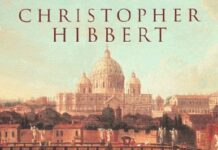
Ebook Info
- Published: 2012
- Number of pages: 467 pages
- Format: PDF
- File Size: 1.58 MB
- Authors: Christopher Hibbert
Description
It was a dynasty with more wealth, passion, and power than the houses of Windsor, Kennedy, and Rockefeller combined. It shaped all of Europe and controlled politics, scientists, artists, and even popes, for three hundred years. It was the house of Medici, patrons of Botticelli, Michelangelo and Galileo, benefactors who turned Florence into a global power center, and then lost it all.The House of Medici picks up where Barbara Tuchman’s Hibbert delves into the lives of the Medici family, whose legacy of increasing self-indulgence and sexual dalliance eventually led to its self-destruction. With twenty-four pages of black-and-white illustrations, this timeless saga is one of Quill’s strongest-selling paperbacks.
User’s Reviews
Reviews from Amazon users which were colected at the time this book was published on the website:
⭐The House of Medici, written by the renowned historian Christopher Hibbert, is a remarkable account about the meteoric rise and calamitous fall of one of Florence’s most powerful and influential families: the Medici. Known for its excentric and fascinating members, the Medici was a family of prestige that had a considerable impact over the Papacy, the development of a stable government in Florence, the finances of Italy and foreign nations, as well as the unity of the numerous kingdoms within the boundaries of Tuscany. The novel contains a collection of biographies of each and every member of the Medici, thoroughly examining the lives of its most significant representatives, such as “Cosimo `the Elder” (“il Vecchio”), Piero di Cosimo de’ Medici (the Gouty), Lorenzo de’ Medici (“Lorenzo The Magnificent”), Piero de’ Medici (“Piero The Infortunate”), Duke Cosimo I, Ferdinando II, Grand Prince Ferdinando, Pope Leo X, Pope Clement VII and many more. The Medici especially excercised their power in the musical and artistic grounds, becoming patrons of the most distinguished artists and musicians of their time, and were eventually responsible for the edification and elaboration of thousands of masterpieces. Their palaces and fortresses are still regarded as part of the most formidable constructions of Florentine history and their regimes were the cause of both the glory and the misfortune of Italy itself. Although the Medici enjoyed an overall favourable reputation, several of its infamous members were the cause of not only the Medici’s misery, but also that of the Florentine population, and ultimately led to the self-destruction of the clan. The Medici’s captivating stories, notable accomplishments and legendary lineage not only bestowed them the title of “Godfathers of the Renaissance,” but also justified the immeasurable power of this illustrious Florentine clan. It’s hard to put the greatness of this literary masterpiece into words, not only because of its enriching content, but its emotive literary style and approach to the Medici members make this book seem even more realistic and even emotional. It seemed to me interesting viewing the lives of each Medici individual in a more humane way, since the connection between the overall account and myself was much deeper, even empathic. The aspect that intrigued me the most about the novel, related to the successive heads (or leaders) of the family, was that they all naturally shared a common interest in wealth and power, arguing amongst themselves and even murdering each other, in order to pursue and obtain full power over the family, consequently Florence and ultimately kingdoms such as Naples, Venice and Rome, as well as the Papacy. It seems to me quite ironic how, even in Renaissance times, charm and popularity were so important in the foundation of such a wealthy family. Although their capital was said to be infinite, and the obtainment of it was due to their hard labor and services to Tuscany and other allies. These bonds and relationships with other disntiguished families, prominent religious leaders and political rulers, set them apart from any common man at that time. It was an imposing family, indeed, of which the Tuscans, especially the Florentines, depended on economically, politically, religiously and sociably. They all intended, in one way or another, to reach a maximum, stable union between the members to fortify their administration and gain more power and, although some attempts succeded, often factors such as wars and adversaries (families like the Pazzi, Albizzi and Borgias or religious leaders such as Girolamo Savonarola and Pope Sixtus IV were major rivals of the Medici family) represented major setbacks to the flourishing and decaying glory of this political, financial and religious dynasty. It also seems to me rather peculiar how, even when their economic atmosphere and social strata varied from one generation to the other, the head members greatly resembled each other in their passions, activities and interests, despite of Florence’s drastic alterations. From the 15th century to the 18th century, Florence underwent an unpredictible but relatively safe period of governance, economics and religion under the directorate of the Medici. They were responsible for the creation of the Medici Bank, one of the largest and most remarkable banks in Europe during its heyday; the creation of four Popes (Pope Leo X, Pope Clement VII, Pope Prius IV, and Pope Leo XI); two queens of France (Caterina de’ Medici and Maria de’ Medici; as well as the dukedom of Florence created in 1532; territorial expansion of Tuscany and lastly, countless achievements in the grounds of music, art, poetry, literacy, philosophy and the sciences. The magnitude of the Medici’s historical footprint, that can still be admired in present day, will remain as a cultural and societal treasure in the years to come. The House of Medici effectively portrays the vibrant period of the Renaissance; the development and expansion of Italian territory; the multiple invasions of Tuscany, ending up in conquest or defeat of foreign conquistadors and lastly, the multiple accomplishments made by the influential dynasty. It demonstrated how the Renaissance, despite of its popularity as a prosperous period of time, faced numerous hitches and wasn’t always a time of static restfulness and splendor. This novel clearly proves the French proverb “Plus ca change, plus le meme chose” is wholly accurate. Also the human culture, especially in the areas of education and society, was tremendously impacted since most of history’s most acclaimed artists, writers, poets, scientists, musicians, scholars and philosophers lived during this period and eventually motivated the foundation of many social movements, ideologies and philosophies. This book not only expounds deeply the social structure, intricate customs and political complexity of that time, but it also gives the reader a wider perception of the Renaissance itself and nourishes the readers’ minds with the vivid memoirs of the evocative Medici members. After reading this splendid compilation of the Famiglia de’ Medici, which I find so arresting and relatable, it is almost impossible for me not to parallel it with the current political, social and economic atmospheres that constelate my life.
⭐fast delivery and great book, thanks very much
⭐I ordered a used book listed as hardbound but received a paperback. Physical condition was ok but there was more annotations than I expected. It’s still a bargain but vendor refunded the cost due to its erroneous listing. I didn’t ask for that but I appreciate the refund. The text itself is a good reference to the Medici dynasty.
⭐Previously, I reviewed the book “The Medici Effect” by Frans Johansson. In his work on innovation, Frans uses the Medici family of Renaissance Florence as template for the kind of enabling patronage that draws together talent from a variety disciplines, arts and sciences – with the ultimate impact of empowering extraordinary levels of creativity and innovation.As I read Johansson’s book, I was struck by the fact that I knew precious little of the history of the Medici and the story behind them emerging as the greatest patrons of the arts the world has ever known. Despite the fact that I have visited Florence, Italy, I still felt that my knowledge of that world needed to be enhanced. As someone who often alludes to Renaissance Men, I felt that it behooved me to learn more about the time and place that spawned the first generation of prototype Renaissance Men – Leonardo, Michelangelo and their ilk.A quick Google search led me to Christopher Hibbert’s classic book on the history of the Medici – “The House of Medici: Its Rise and Fall.” Hibbert does a nice job of leading the reader through a Grand Tour of several generations of the Medici – bankers to the Papacy who investments a large portion of their largesse in supporting artists and scholars of many stripes. A nice set of endnotes provides a parallel tour through the architectural history of all of the sites mentioned in the body of the text.While I will not take the time for a full review here, I do want to share some insight that I gleaned early in the book that shed important light on how Florence emerged as the haven for genius that turned it into the magnet that it remains today for people who want to experience the glory of its Golden Age.In 1438, Cosimo Medici arranged for a Council to be convened in Florence that would attempt to repair the breech between the Roman Church and the Orthodox Church centered in Constantinople. The Council ultimately failed to bridge that theological chasm, but had more salubrious effects on the reputation of Florence as a center for the arts and scholarship.”Yet for Florence, as Cosimo had foreseen, the Council had happier consequences. As well as profiting the trade of the city, it was an important influence on what was already being spoken of as the Rinascimento [“Renaissance”]. The presence of so many Greek scholars in Florence provided an incalculable stimulus to the quickening interest in classical texts and classical history, in classical art and philosophy, and particularly in the study of Plato, the great hero of the humanists, for so long overshadowed by his pupil, Aristotle.” (Page 68)This book helped me to fill in some missing pieces in my understanding of how the Renaissance emerged from the Dark Ages that had beclouded and adumbrated Europe for so many centuries. I recommend it as a useful resource for those, who like me, are not serious students of history, but who desire to know more than “the average bear” about the intellectual history of Western Civilization.Enjoy.Al
⭐This is a very readable history. Mr Hibbert does have a way of making his topic very interesting and makes you want to keep reading. However, as a history student, I have to wonder at how much he left out and perhaps embellished. This book was written in 1974 and it shows; the author appears to skirt over the roles of many notable members of the family – namely the women, mentioning them only in passing and this includes Catherine de Medici. He also seems to have relied on mainly secondary sources with primary sources at a minimum. This does make me wonder how much ‘creative licence’ has been used especially when describing in great detail some of the banquets and eating habits of members of the family.He doesn’t really tell us about the rise and fall in the traditional sense. He concentrates, instead, on detailed information of the artworks and artists involved. I feel this book was rather rushed in places, especially towards the end and leaves one with rather a lot of questions rather than answers. In essence, however, this is a good place to start if one is interested in the Medici but don’t rely on it to give you a good, solid history of the rise and fall of the family.
⭐An excellent companion to a visit to Florence, the book brings the city’s history alive and the city brings the book alive.
⭐Arrived as described – used but in good condition. Large enough font to read in bed and well set out with history about the Medici. A good accompaniment to the Netflix series
⭐I’ve just watched The Medicis on TV and thought this would fill in some of the gaps. I really enjoyed this book. It’s very knowledgeable and well researched as you’d expect from this author. I love Florence and the surrounding area. I would read this book again probably before I go to Florence again.
⭐An encyclopedia of who’s who in the Medici world.This would be very helpful for anyone doing research. Very factual.
Keywords
Free Download The House Of Medici: Its Rise and Fall in PDF format
The House Of Medici: Its Rise and Fall PDF Free Download
Download The House Of Medici: Its Rise and Fall 2012 PDF Free
The House Of Medici: Its Rise and Fall 2012 PDF Free Download
Download The House Of Medici: Its Rise and Fall PDF
Free Download Ebook The House Of Medici: Its Rise and Fall





